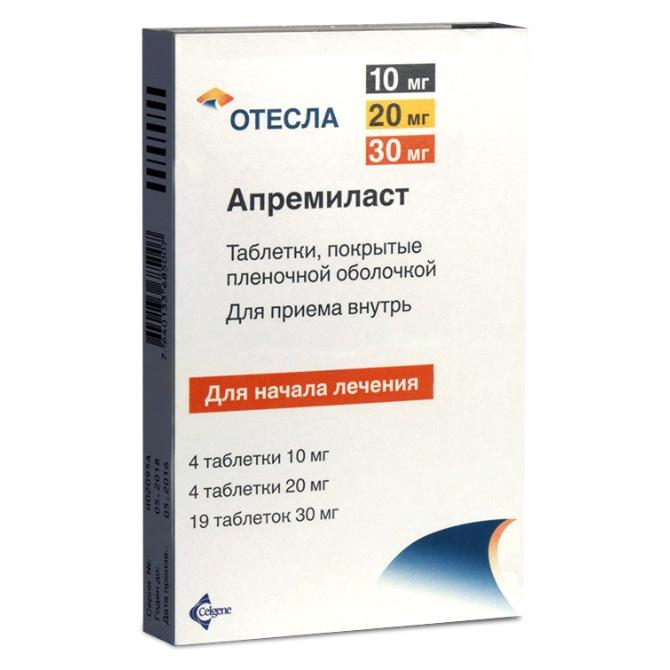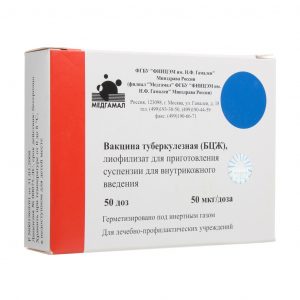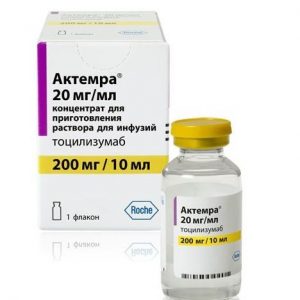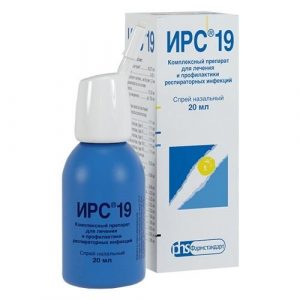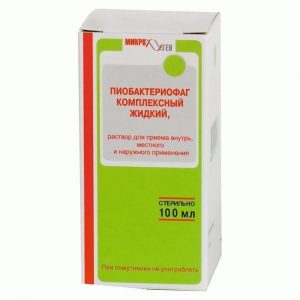Description
Pharmacological action of
Mechanism of action of
Apremilast is a small molecule, an inhibitor of PDE-4, which acts inside the cell, modulating pro-inflammatory and anti-inflammatory mediators. PDE-4 is a specific PDE of cAMP that dominates PDE in inflammatory cells. With inhibition of PDE-4, the amount of cAMP increases, which, in turn, leads to the suppression of the inflammatory response by modulating the expression of TNF- ±, IL-23, IL-17, and other inflammatory cytokines. cAMP also modulates levels of certain anti-inflammatory cytokines, such as IL-10. These pro- and anti-inflammatory mediators are involved in the pathogenesis of psoriasis and psoriatic arthritis (PsA).
Pharmacodynamic effects of
In clinical trials in patients with PsA, apremilast significantly modulated but did not completely inhibit blood plasma proteins: IL-1 , IL-6, IL-8, monocytic chemoattract protein-1 (MXE-1), macrophage inflammation protein-1 (MBB-1 ), Matrix metalloproteinase-3 (MMP-3) and TNF- ±. After 40 weeks of treatment with apremilast, a decrease in the concentration of IL-17 and IL-23 and an increase in the concentration of IL-10 in blood plasma were noted. In patients with psoriasis, apremilast reduced focal epidermal thickening of the affected areas of the skin, inflammatory cell infiltration, and expression of pro-inflammatory genes, including genes for induced nitric oxide synthase (iNOS), IL-12 / IL-23p40, IL-17A, IL-22, and IL-8.
Apremilast when administered in doses up to 50 mg 2 times a day does not extend the QT interval in healthy subjects.
1493 patients with active PsA ( 3 swollen joints and 3 painful joints), in spite of previous therapy with low molecular weight or biological disease-modifying drugs (BMS) lasting at least 6 months, they received oral placebo, apremilast 20 mg or apremilast 30 mg 2 times a day. Apremilast was used as monotherapy (34.8%) or in combination with stable doses of low molecular weight BMD (65.2%). 76.4% of patients previously received only low molecular weight BMD, and 22.4% of patients were previously treated with biological BMD, among which 7.8% of this therapy was ineffective. The average duration of PsA is 5 years.
Apremilast therapy led to a significant improvement in PsA symptoms compared to placebo.
The effectiveness of treatment with apremilast did not differ in patients who simultaneously received or did not receive BMS, including methotrexate. In patients who have had BMD or biological BMD before apremilast therapy, the therapeutic effects of apremilast were more pronounced than those taking a placebo. A significant, statistically significant improvement in functional activity was noted with apremilast therapy.
In total, 1257 patients with moderate to severe plaque psoriasis who were scheduled to undergo phototherapy or systemic therapy were randomized to a placebo group or an apremilast group (by mouth, 30 mg 2 times a day). Approximately 30% of patients have not previously received phototherapy, standard systemic or biological drugs.
During treatment with apremilast in patients with moderate to severe psoriasis, a significant improvement was noted compared with placebo. The effectiveness of apremilast was manifested in relation to the complex of clinical manifestations of psoriasis, including itching, damage to the nails and scalp, as well as quality of life.
The clinical efficacy of apremilast has been confirmed in various subgroups of patients formed by the initial demographic and clinical characteristics (including the duration of psoriasis and the presence of PsA in history). The positive clinical effect of the drug did not depend on the previous drug therapy of psoriasis and its results. The response to treatment with apremilast was quick and expressed in a significant reduction in the symptoms of psoriasis by the 2nd week of treatment, compared with placebo.
Indications
Psoriatic arthritis
Treatment of active psoriatic arthritis (PsA) in adults in monotherapy or in combination with basic anti-inflammatory drugs (BPV) with an insufficient response or with intolerance to previous therapy for BPV.
Psoriasis
Treatment of plaque psoriasis of moderate and severe severity in adults with an insufficient response, the presence of contraindications or intolerance to basic anti-inflammatory therapy, including cyclosporine, methotrexate or drugs used together with ultraviolet-A radiation (PUVA).
Contraindications
Hypersensitivity to apremilast or other components of the
preparation Pregnancy
Breastfeeding period
Children under 18 years of age (insufficient clinical experience)
Rare hereditary galactose galactose intolerance, galactose galactose intolerance, lactose).
With caution
In patients who have a history of mental illness or are indicated to have a history of it, or if the patient is planning to take other concomitant drugs that can cause mental health problems (see the section Special Instructions ).
In patients with severe renal failure (see section “Pharmacokinetics”, “Dosage and Administration”, “Special Instructions”).
In patients with insufficient body weight (see section “Special instructions”).
Use during pregnancy and lactation
Pregnancy must be excluded before treatment. Women capable of childbearing should use an effective method of contraception during therapy.
Data on the use of apremilast in pregnant women is limited. Apremilast is contraindicated in pregnancy. In mice and monkeys, its effects are embryofetal losses, fetal weight reduction and delayed ossification in mice at doses higher than the maximum doses for humans. If the exposure is 1.3 of the level of clinical exposure, then the negative effect does not develop (see “Pharmacokinetics”).
Apremilast was found in the milk of mice. It is not known whether apremilast or its metabolites enter human milk. Since the risk of unwanted effects on the baby during breastfeeding cannot be ruled out, apremilast should not be used during breastfeeding.
Special instructions
Patients with rare hereditary disorders such as galactose intolerance, with congenital lactase deficiency, or with malabsorption of glucose-galactose should not take this drug.
Mental disorder: the use of apremilast is associated with an increased risk of developing mental disorders, such as insomnia and depression. Cases of the appearance of suicidal thoughts and behavior, including suicide, were noted in patients with an indication of a history of depression and without it (see the section “Side effects”).
The risks and benefits of initiating and continuing apremilast therapy should be carefully evaluated in those patients who report a history of mental disorders or have a history of them, or if the patient is planning to take other concomitant drugs that can cause mental disorders.
The patient and caregivers should inform the prescribing physician of any changes in the patient ² ¢s behavior or mood, as well as suicidal thoughts. Severe renal failure: in patients with severe renal insufficiency, the dose of the Otesla drug should be reduced to
30 mg once a day (see the section “Pharmacokinetics” and “Method of administration and doses”). Underweight patients: In patients with insufficient body weight, at the beginning of the course of therapy, it is necessary to regularly monitor body weight during treatment. In the case of an unexplained or clinically significant decrease in body weight, a thorough medical examination of the patient is necessary and consideration is given to stopping treatment.
Influence on the ability to drive vehicles and mechanisms: apremilast does not affect or slightly affects the ability to drive vehicles or work with mechanisms.
Composition of
Active ingredient:
apremilast – 10/20/20 mg
Dosage and administration
For oral administration.
Treatment with Otesla can only be prescribed by a specialist who has sufficient experience in the diagnosis and treatment of psoriasis and psoriatic arthritis.
Coated tablets should be swallowed whole, preferably washed down with water. Take regardless of the time of meal.
Doses
The recommended dose of apremilast is 30 mg orally 2 times a day, morning and evening, with an interval of about 12 hours. Initial dose titration is required. After the initial titration, re-titration is not required.
Side effects of
The most frequent adverse drug reactions (NLR) during phase III clinical trials were gastrointestinal disorders – diarrhea (15.7%) and nausea (13.9%). Basically, these disorders were mild or moderate in severity and only 0.3% of each of these NLRs were regarded as severe. These NLRs occurred predominantly in the first 2 weeks of treatment and usually resolved within 4 weeks. Other common NLRs were upper respiratory tract infections (8.4%), headache (7.9%), and tension headache (7.2%). In general, most NLR were mild or moderate.
Hypersensitivity reactions have rarely been reported in clinical trials of apremilast. NLR has been reported in clinical trials of apremilast for psoriatic arthritis (1945 patients) and psoriasis (1184 patients). Infectious and parasitic diseases: bronchitis, upper respiratory tract infections, nasopharyngitis. Immune system disorders: hypersensitivity reactions. Metabolic and nutritional disorders: decreased appetite. Mental disorders: insomnia, depression. Disorders of the nervous system: migraine, tension headache, headache. Disorders of the respiratory system, chest and mediastinal organs: cough. Disorders of the gastrointestinal tract: diarrhea, nausea, vomiting, dyspepsia, frequent stools, pain in the upper abdomen, gastroesophageal reflux, gastrointestinal bleeding. Disorders of the skin and subcutaneous tissue: skin rash. Musculoskeletal and connective tissue disorders: back pain. General disorders and disorders at the injection site: fatigue. Laboratory and instrumental data: weight loss.
Drug Interactions
Combined with the powerful inducer of the cytochrome P450 3A4 isoenzyme (rifampicin), rifampicin, weaken the systemic effects of apremilast and reduce its effectiveness. Therefore, the combined use of potent inducers of the CYP3A4 isoenzyme (e.g. rifampicin, phenobarbital, carbamazepine, phenytoin and Hypericum perforatum preparations) with apremilast. With the simultaneous re-use of apremilast and rifampicin, AUC and Cmaxapremilast decrease by 72 and 43%, respectively. Under conditions of combined use of apremilast with powerful inducers of the CYP3A4 isoenzyme (for example, rifampicin), the clinical response may decrease. During clinical trials, apremilast was combined with local therapy (corticosteroids, tar tar, salicylic acid preparations for treating the scalp) and UV-B phototherapy.
No clinically significant drug interaction between ketoconazole and apremilast was detected. Apremilast can be combined with potent inhibitors of the CYP3A4 isoenzyme, such as ketoconazole.
No pharmacokinetic drug interaction between apremilast and methotrexate was detected in patients with PsA. Apremilast can be combined with methotrexate.
No pharmacokinetic drug interaction observed between apremilast and oral contraceptives containing ethinyl estradiol and norgestimate. Apremilast can be combined with oral contraceptives.
Overdose
Apremilast was studied in healthy volunteers at a maximum daily dose of 100 mg (50 mg 2 times a day) for 4.5 days without signs of dose-limiting toxicity. In case of an overdose, monitoring of the symptoms and signs of NLR is recommended. If necessary, symptomatic and supportive treatment is prescribed.
Storage conditions
Store at a temperature not exceeding 30 ° C. Keep out of the reach of children.
Expiration
2 years.
pharmacy terms for prescriptions
Form of Treatment
tablets
Seldžen INTERNATIONAL Sarl, Switzerland
